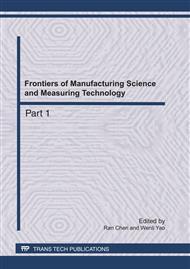[1]
Z.G. Ying, Y.Q. Ni and J.M. Ko. Semi-active optimal control of linearized systems with multi-degree of freedom and application. Journal of Journal of Sound and Vibration Vol. 279(1-2) (2005), pp.373-388.
DOI: 10.1016/j.jsv.2003.11.004
Google Scholar
[2]
X.J. Wang, F. Gordaninejad. Study of magnetorheological fluids at high shear rates. Rheol Acta Vol. 45(2006), p.899–908.
DOI: 10.1007/s00397-005-0058-y
Google Scholar
[3]
A. Dorfmanna, R.W. Ogden, A.S. Wineman. Athree-dimensional non-linear constitutive law for magnetorheological fluids with applications. International Journal of Non-Linear Mechanics Vol. 42 (2007), p.381 – 390.
DOI: 10.1016/j.ijnonlinmec.2007.03.002
Google Scholar
[4]
G. Q. Yang. Large-Scale Magnetorheokogical Fluid Damper for Vibration Mitigation: Modeling, Testing and Control. Indiana: University of Notre Dame, (2001).
Google Scholar
[5]
M. Ahmadian, A. J. Norris. Experimental analysis of magnetorheological dampers when subjected to impact and shock loading. Communications in Nonlinear Science and Numerical Simulation Vol. 13 (2008), p.1978–(1985).
DOI: 10.1016/j.cnsns.2007.03.028
Google Scholar
[6]
W. B. Collis, P. R. White, J. K. Hammond. Higher-order spectra: the bispectrum and trispectrum. Mechanical System and SignalProcessing Vol. 12(1998), pp.375-395.
DOI: 10.1006/mssp.1997.0145
Google Scholar
[7]
P. Q Xia. An inverse model of MR damper using optimal neural network and system identification. Journal of Sound and Vibration Vol. 266(2003), pp.1009-1023.
DOI: 10.1016/s0022-460x(02)01408-6
Google Scholar
[8]
M. Yu, X.M. Dong, S.B. Choi. Human simulated intelligent control of vehicle suspension system with MR dampers. Journal of Sound and Vibration Vol. 319 (2009) , pp.753-767.
DOI: 10.1016/j.jsv.2008.06.047
Google Scholar
[9]
L. Richter, L. Zipser, U. Lange. Properties of magnetorheologic fluids. Sensors and Materials Vol. 13 (2001), pp.385-397.
Google Scholar


